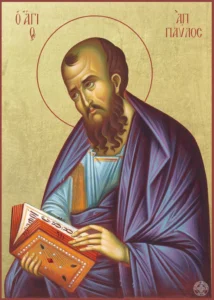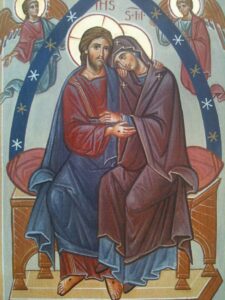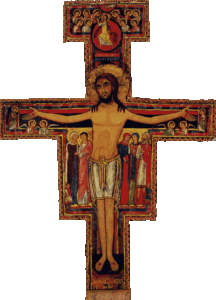Yes, Christ has indeed qualified us as ministers of a new covenant (or New Law) (2 Cor 3:6). When did He qualify us? When He instituted the Catholic priesthood, ordaining the Apostles and ordering them, Do this in memory of me (Lk 22:19). He could make us participants in His priesthood because He was the first and High Priest. In effect, upon becoming Incarnate in the womb of the Virgin, that is, upon assuming a human nature, uniting Himself to it hypostatically, He was constituted as the High and Eternal Priest, consecrated and anointed by the Holy Spirit,[1] and sent by the Father for a mission: the mission of saving all men, making them participants in His anointing.[2]
With the Incarnation of the Word, we have a New Priest and, because we have a New Priest, we have a New Covenant or a New Law; we also have a New Sacrifice, because when there is a change of priesthood, there is . . . a change of law (Heb 7:12). Thus, we are ministers of the New Covenant because Christ inaugurated a New Priesthood.
This is a new priesthood, because Jesus Christ, of whom these things are said, belonged to a different tribe,[3] a tribe from which no one served at the altar.[4] It is clear that our Lord came from the tribe of Judah, and Moses never referred to this tribe when he spoke about the priesthood.[5] Thus Jesus Christ is not a priest according to Aaron, but rather according to Melchizedek because He gave rise to another priest . . . according to the order of Melchizedek, and not reckoned according to the order of Aaron (Heb 7:11). The priesthood of Jesus Christ does not belong to the Levitical or Aaronic priesthood.
Christ’s is a perfect priesthood, that is, one that can lead men to perfection, to perfect union with God. The Levitical priesthood was not: If, then, perfection came through the Levitical priesthood, on the basis of which the people received the law, what need would there still have been for another priest to arise according to the order of Melchizedek, and not reckoned according to the order of Aaron? (Heb 7:11). On account of the imperfection of the Levitical priesthood–a priesthood which was incapable of giving moral sanctification and for providing eternal salvation[6]–God instituted a new and different priesthood, a perfect one.
God substituted the imperfect with the perfect, and not the reverse, as Saint Paul teaches: when the perfect comes, the partial will pass away (1 Cor 13:10). “The one was the model; the other was found to be the finished product. For God replaced the lamb, and a man the sheep; but in the man was Christ, who contains all things,” as Meliton of Sardes says.[7]
It is a priesthood that is totally distinct, of a different species, which is indicated by the words that are used: “This distinction is indicated with the word e[teroj, as the voice e[teroj does not indicate ‘another (a;lloj) priest of the same genus’ but rather ‘another of a diverse species.’ Moreover, the diversity of this priesthood is also shown by Psalm 110:4, where the new priesthood is named not according to the order of Aaron but rather according to the order of Melchizedek.”[8]
As such, Jesus Christ’s priesthood does not follow the Levitical priesthood; rather, the Levitical priesthood is abolished, overturned, and changed, in such a way that the Levitical priesthood is converted into something dead (it is no longer binding nor does it have expiatory virtue) and deadly (whoever observes its practices, knowing that they have been abolished, is guilty of mortal sin).[9]
When Saint Thomas comments on these texts from the Letter to the Hebrews he writes: “The priesthood of Christ is preferred
/ is in a place of pre-eminence with respect to / overtakes / surpasses the Levitical priesthood”[10] (Sacerdotium Christi praefertur sacerdoctio levitico).
Jesus Christ’s priesthood is one of effective mediation; it carries out what it signifies: It is even more obvious if another priest is raised up after the likeness of Melchizedek, who has become so, not by a law expressed in a commandment concerning physical descent but by the power of a life that cannot be destroyed. For it is testified: ‘You are a priest forever according to the order of Melchizedek.’ On the one hand, a former commandment is annulled because of its weakness and uselessness, for the law brought nothing to perfection; on the other hand, a better hope is introduced, through which we draw near to God (Heb 7:15-19). The Levitical priesthood was an ineffective mediation.
Jesus Christ’s priesthood was made under an oath of God:
And to the degree that this happened not without the taking of an oath for
others became priests without an oath, but he with an oath, through the one who said to him: “The Lord has sworn, and he will not repent: ‘You are a priest forever’” to that same degree has Jesus (also) become the guarantee of an (even) better covenant (Heb 7:20-22).
Jesus Christ’s priesthood is one and perpetual: Those priests were many because they were prevented by death from remaining in office, but he, because he remains forever, has a priesthood that does not pass away. Therefore, he is always able to save those who approach God through him, since he lives forever to make intercession for them. It was fitting that we should have such a high priest: holy, innocent, undefiled, separated from sinners, higher than the heavens. He has no need, as did the high priests, to offer sacrifice day after day, first for his own sins and then for those of the people; he did that once for all when he offered himself. For the law appoints men subject to weakness to be high priests, but the word of the oath, which was taken after the law, appoints a son, who has been made perfect forever (Heb 7:23-28). Jesus Christ has no successors. No one succeeds Jesus Christ; no one substitutes Him. There cannot be a more perfect priesthood. The Apostles and their successors do not multiply the one Priesthood of Jesus Christ; only the subjects who participate in the one Priesthood of Jesus Christ are multiplied. Not even the Pope is the successor of Jesus Christ: not even all the popes together, not even with all the bishops and all the priests together. The Pope is only the successor of Saint Peter. There is no successor of Jesus Christ; there is only a Vicar.
Jesus Christ doesn’t succeed anyone because His priesthood is new. Every priesthood depends on Jesus Christ, either by being a figure in the Old Testament or by being the reality in the New; this is because His priesthood is the High priesthood. Jesus Christ is not succeeded by anyone, because His priesthood is eternal.
The Levitical priesthood was temporal; that of Jesus Christ is eternal. The Levitical priesthood was changeable; that of Jesus Christ is immutable. The Levitical priesthood was a figure that passes; that of Jesus Christ is the reality that endures for forever and ever. The first was only for the Jewish people, while the second is for all people, for all of humanity, throughout all centuries, for all races, in all cultures, and in all languages.
The old law precedes the Levitical priesthood, but the New Priest precedes the New Law. This is the way that it appears in the gloss on the basis of which the people received the law (Heb 7:11). The gloss, on the basis of which–evpV auvth–the people received the law, shows the weakness and impotence of the law itself; the expression evpV auvth,, sub ipso, refers to the Levitical priesthood, and does not mean that the people in the time of the priesthood received the law, given that this would suppose that the priesthood had its origins before the law. This is not the case, as evpi with the genitive means “that in which (quo) something is supported (is based, is founded: innititur)”; in our example it means that “the law is based (innixa est) in the priesthood,”[11] in such a way that the priesthood is the foundation upon which the entire Law is constructed; the Law is founded in the priesthood, and it cannot survive without it, from which it follows that if the priesthood is imperfect, a fortiori the law which is based upon the priesthood is as well. The author points out in verse 12: When there is a change of priesthood, there is necessarily a change of law as well. The suppression of the priesthood asks for the suppression of the entirety of the old economy. However, in what way is the law founded in the priesthood? The priests performed the worship that should lead men to union with Yahweh; the worship itself is directed by the law, so thus the law, in large part, draws near to worship, and in this way it should order the worship so that men might effectively reach the end desired. Thus, the law is based in the worship, and the worship, for its part, in the priesthood; if the priesthood is imperfect, then the worship will also be imperfect, and so will the law.
Father Spicq says: “The gloss on the basis of which the people received the law supposes that religion serves to gain access to God, and, consequently, it is concentrated or essentially reposes on priest; as such, it means that the entire Mosaic institution is subordinated to the Levitical priesthood, and that it is from there that it has its validity and its religious efficacy. If this foundation is demolished, the law falls with it.
The conclusion is that, as the coming of Christ changed the priestly order, a metathesis[12] is produced, a total change in the old law that had not been given to more than a single people and only for a determined time. It should be observed that the priesthood was not eliminated, for this institution will always remain indispensable for uniting men with God; however, there was an evolution in the providential economy of salvation. In consequence, the transformation and the passage from one covenant to another were not only inevitable, but rather even concomitant.”[13]
Saint Thomas had already taught this: “For the Law was under the administration of the priesthood; therefore, the priesthood being translated, it is necessary that the Law be changed; just as a person who changes his mind about traveling by water, changes his mind about finding a ship. But every Law is ordained to leading one’s life according to some rule. Hence, according to the Philosopher in the Politics, when the mode of life is changed, it is necessary for the law to be changed. But just as human law is ordained to human guidance, so a spiritual and divine law to divine guidance. But this guidance is regulated by a priesthood. Therefore, the priesthood being translated, it is necessary that a translation be made of the Law.”[14]
In the cited paragraph, the divine law is ordered to the divine guidance, codified by the priesthood. The Law was ordered to the priesthood. It is the priest who is the mediator between God and men, and he mediates, that is, unites, by administering a regimen of sanctification (guiding souls in the sense of directing them towards God). When the priesthood changed in its essence, it clearly changed its guidance of souls, its mode of directing them to God. Thus, the Law is, in a certain way, the expression of the nature of the priesthood.
This is why the Angelic Doctor continues by forcefully pointing out that it is the priesthood that changes and not the priest: “But he [the author of the Epistle] speaks carefully, because he does not say, ‘The priest being translated’: for the law does not regard the person of the priest. Hence, when the priest dies, the law is not changed, unless perchance the entire method and order of guidance is changed. On the other hand, having translated the priesthood, the entire method and order of guidance is changed.”[15]
The dependence of the law on the priesthood is clear, but given that the Law was prior to the Levitical priesthood, such a dependency is only possible if the Law is ordered to the priesthood as its end. This is reinforced by the exception introduced in order to distinguish between the priest and the priesthood: the law does not change on account of the priest unless it had been given by that person, that priest himself. The Old Law was not given in service of a particular priest but rather in service of the old priesthood. For what purpose? It was given in service of a priesthood– and of the salvific economy based in that priesthood–that was inefficient, so that man sub lege would prove his inability to save himself from the sin; the law showed him his sins without giving the efficacy to overcome them.
Both the Levitical priesthood and the Priesthood of Jesus Christ, in their own ways, were mediators between God and men, and both, in their ways, were administrators of the law; however, they are mediators and administers of different species. We will see the differences with respect to their teaching, to sanctification, and shepherding. In their preaching, the ministers of the New Covenant should be in tune with the wind of Pentecost, in some way exhaling the Holy Spirit, and knowing how to speak to the interior Master who is present in all the baptized. There is no external letter that could be worth more. There is no Masora that could be worth more than the infused Law.
In the shepherding of souls, the ministers of the New Covenant should know that those souls are not theirs, but rather Christ’s.[16] We are not sheep of that Pope, or of this bishop, or of that priest. No Pope, no bishop, no priest will resurrect on the third day for us. Yes, we are of that Pope, that bishop (our own ordinary), of that priest, in the sense that they are the means given by Jesus Christ to genuinely unite ourselves to Him. None of us who are here want to devote ourselves to God only for this Pope, or that bishop, or that priest, and, if there were someone like that, the best thing that they could do is to return home.[17] Our only interest with respect to the sheep should be to be of service to them, of which Jesus Christ Himself left us an example. If you have some other interest, go home! The Shepherd of the New Covenant is the one who lays down his life for the sheep (Jn 10:11).
The ministers of the New Covenant exist for the sanctification of men. The Hebrews burnt a massacre of victims on the altar of the Temple in Jerusalem, on Mount Zion, an altar of 14 meters by 14 meters by 4 meters high; it was there that those offerings were burned by fire that came from heaven, a fire that was never to go out. Do Christians now have a sacrifice that effectively unites them to God? Certainly there is a unique sacrifice: that of the cross. However, this happened almost 2000 years ago: does this mean that men of the following generations, of this generation, and of those to come, don’t have a sacrifice as their nature requires? In no way! The Lord established the Sacrifice of the New Covenant for all times when He died on the Cross, which, in turn, He ordered to be perpetuated at the Last Supper. Does this mean that men don’t have a bloody sacrifice to offer God for their sins? Correct. The One who is offered in the Mass is the same Victim of the cross; it is the same Body given up and the same Blood shed on the cross, although in an unbloody form, in a distinct species, that is, sacramentally. The New Law, which is the Law of the Spirit, demands it from those who are ministers by the oath and promise of God. But, is there a fire? Yes, there is, because the Holy Spirit is the ignis altaris (Rev 8:5).[18] But, is there a knife that makes a victim? Yes there is, because the priest, upon consecrating the species of bread and wine, separates “with an unbloody slash the Body and Blood of the Lord, using his voice as a sword,” as Saint Gregory of Nazianzus said.[19] Moreover, the principal instrument of the victimization is love as “Amor sacerdos inmolat!”
In this way, we don’t have millions of victims in the New Covenant, but rather Only One Victim, who forms only one Mystical Body. We don’t have thousands of priests, but Only One Priest, in Whom we offer the same and only sacrifice, as we offer it in persona Christi. We don’t have only one Temple with only one altar, but rather thousands of Temples with thousands of altars that are only one. We don’t have sacrifices that are visibly bloody, but rather that are unbloody, as corresponds to the Law of the Spirit, as corresponds to the New and Eternal Covenant.
The New and Eternal Priest, who was a virgin and of a virgin mother, inaugurated the Covenant of the Spirit. As by a certain con-naturality, He has acted so that His ministers might be celibate: certainly all those of the first order (bishops), those of the second order (in the Latin rite), and the innumerable lay men and women of all time who “are a divine gift, which the Church received from its Lord and which it always safeguards with the help of His grace.”[20]
We are (or we will be) “ministers of the New Covenant.” Let us never forget it! It is our mark of honor!
[1] Cfr. Lk 4:18.
[2] Cfr. Ecumenical Second Vatican Council, Decree on the Ministry and Life of Priests, Presbyterorum Ordinis, 2.
[3] Cfr. Mt 1:16.
[4] L. Cl.Fillion, Sainte Bible, VIII (Paris 1903) 578: To serve at the altar: “A solemn expression that summarizes the functions of the priests.”
[5] Cfr. Heb 7:13-14.
[6] J. M. Bover, Teología de San Pablo (Madrid 1967) 281.
[7] Meliton of Sardes, Concerning the Passover, Num. 2-7. 100-103: SC 123, 60-64. 120-122: “Figura enim tránsiit et véritas est invénta.”
[8] P. F. Ceuppens, Quaestiones selectae ex epistulis S. Pauli (Rome 1951) 211. From the word e[teroj (heteros) we have such English words as heterogeneous; from a;lloj (allos) we have words such as else.
[9] Cfr. Saint Thomas Aquinas, S. Th., I-II, q. 103, a. 4, ad 1.
[10] Saint Thomas Aquinas, Ad Haeb. 7, 3.
[11] Cfr. F. Zorell, Lexicon graecum NT (Paris 1931) 473.
[12] The word used in the Greek text of Heb 7:12 in order to indicate the change of the law is μεταθεσί.
[13] C. Spicq, L’épitre aux Hebreux (Paris 1977) 124-125. Ceslas Spicq is a renowned Biblical scholar.
[14] Ad Heb., VII, III, 350.
[15] Ad Heb., VII, III, 351.
[16] Cfr. Jn 21:15-17.
[17] In this homily, Fr. Buela was speaking to seminarians and priests, and so by returning home he means that the seminarians should leave the seminary if they devoted themselves to God just for a particular priest.
[18] Cfr. Heb 9:14.
[19] Enchiridium Patristicum, 171.
[20] Cfr. Ecumenical Second Vatican Council, Dogmatic Constitution on the Church, Lumen Gentium, 43.






